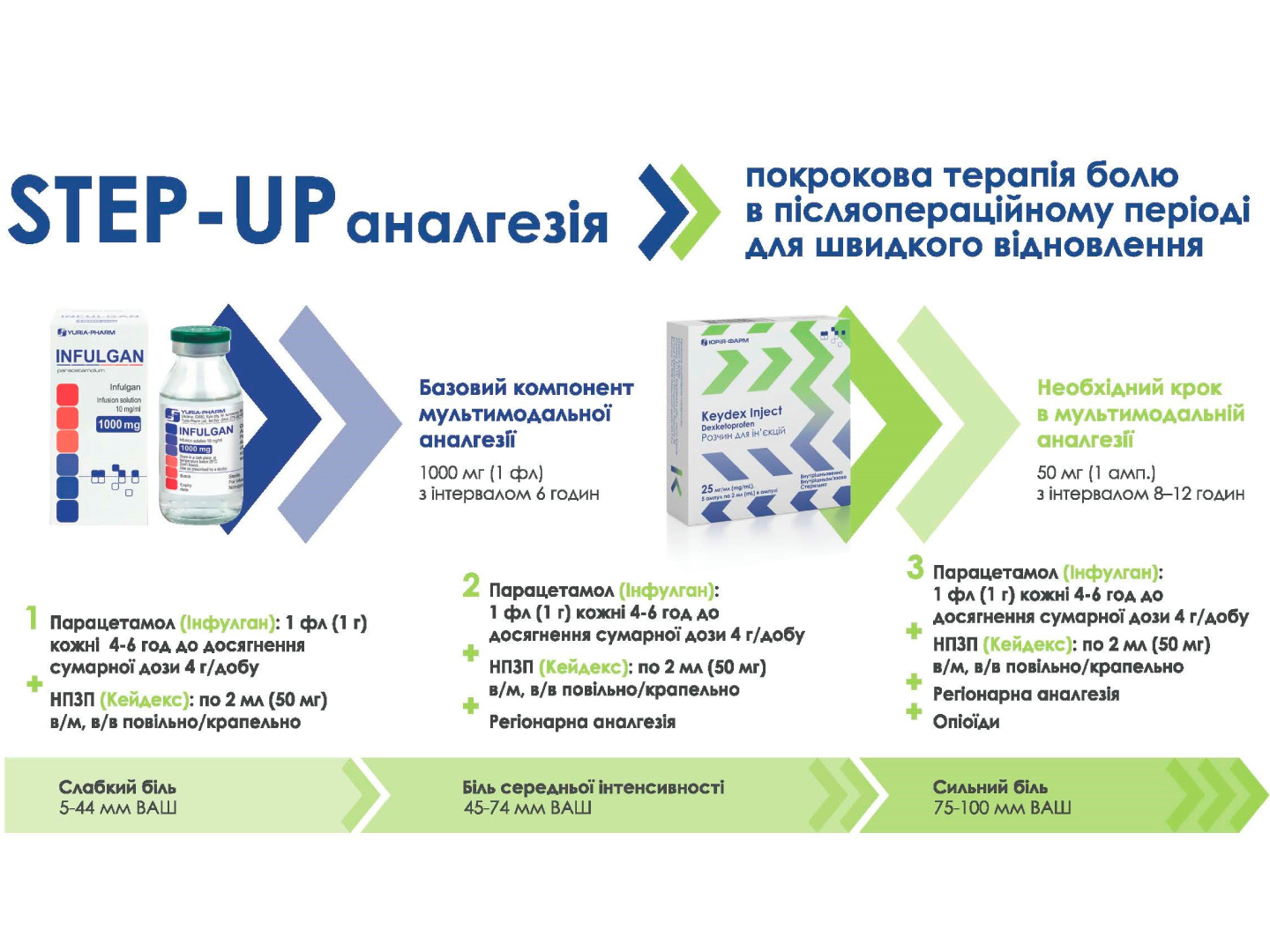Peculiarities of pain management in pregnant women and women in labor

Purpose – to evaluate the efficacy and adverse side effects (if any) of intravenous infusion of 1000 mg paracetamol as a method of pain relief in labour during the active phase of labour and in the postoperative period after caesarean section.
Materials and methods. 43 pregnant women in the first stage of labor with active labor were studied. The selection criteria were healthy low-risk first-term mothers; aged 18–35 years; with spontaneous onset of labor at 37–40 weeks of pregnancy; the first period of labor with the opening of the cervix by 3–5 cm; one live fruit; main presentation Infulgan inf. solution was chosen as a paracetamol preparation 10 mg/ml per 100 ml. Multimodal anesthesia with a combination of the drugs Infulgan (paracetamol) and Keydex (dexketoprofen) was performed for postoperative analgesia.
The pain intensity indicator was determined using the visual analog scale (VAS) – a method of subjective pain assessment. The patient marked a point on a non-graduated ruler 10 cm long, which corresponds to the degree of severity of pain. During the dynamic evaluation of changes in pain intensity, they were considered objective and significant if the true VAS value differed from the previous one by more than 1.3 cm.
The comparison group consisted of 20 pregnant women in the 1st stage of labor who did not receive anesthesia at their own request. Also, a study of the effectiveness of complex multimodal anesthesia (Infulgan (paracetamol) and Keydex (dexketoprofen)) was conducted in 5 (11.6%) women in labor after delivery by caesarean section.
Results. The use of intravenous paracetamol injection for analgesia during labor is an effective analgesia. There was an initial but significant decrease in the VAS score 30 minutes after Infulgan administration and a statistically significant decrease in pain after 2, 3 and 4 hours compared with the VAS score before treatment.
In the group of women who did not undergo analgesia, the intensity of the pain syndrome steadily increased. In the postoperative period, after caesarean section, women underwent combined analgesia with the use of Infulgan (paracetamol) drugs as the basic component of multimodal analgesia and Keydex (dexketoprofen) as a necessary step of multimodal analgesia. The above-mentioned combination of drugs allows for Step-Up analgesia – step-by-step pain therapy. Infulgan was administered in 1 vial (1000 mg) every 6 hours by intravenous injection, and Keydex – in 1 ampoule every 8 hours by intramuscular injection. The addition of Keydex (dexketoprofen) to the analgesia provided an adequate analgesic effect and did not require the administration of opioid analgesics in the postoperative period.
The research was carried out in accordance with the principles of the Helsinki Declaration. The study protocol was approved by the Local Ethics. Committee of all participating institutions. The informed consent of the patient was obtained for conducting the studies. No conflict of interests was declared by the authors.
Keywords: labor analgesia, multimodal anesthesia, non-opioid analgesics.
Authors: Iu.V. Davydova, O.V. Maryasova, A.Yu. Lymanska, О.M. Kravets (SI «Institute of Pediatrics, Obstetrics and Gynecology named after аcademician O.M. Lukyanova of the NAMS of Ukraine», Kyiv).
Conclusions:
Intravenous paracetamol is an effective non-opioid drug for the relief of labor pain without any significant side effects for mother and fetus. The absence of any maternal side effects (sedation, respiratory depression, delayed gastric emptying, nausea and vomiting) or neonatal side effects (respiratory depression and decreased Apgar scores) associated with opioids allows us to recommend Infulgan for the relief of labor pain. The step-by-step Step-Up pain therapy in the postoperative period allows you to reduce the doses of each of the analgesics and reduce the frequency and side effects of the drugs. The use of Infulgan and Keydex as a method of pain management by means of Step-Up analgesia in the postoperative period in parturient women showed high efficiency, adequate tolerability and patient’s satisfaction.
Literature:
- Graham GG, Scott KF, Day RO. Tolerability of paracetamol. Drug Saf. 2005;28(3):227–40.
- Smith HS. Potential analgesic mechanisms of acetaminophen. Pain Physician. 2009;12(1):269–80.
- American College of Obstetricians and Gynecologists’ Presidential Task Force on Pregnancy and Heart Disease and Committee on Practice Bulletins–Obstetrics. ACOG Practice Bulletin No. 212: Pregnancy and Heart Disease. Obstet Gynecol. 2019 May. 133 (5):e320-e356.
- Lowe NK. The nature of labour pain. American Obstetric Gynaecology. 2002;186(5):S16–S24.
- Pandya ST. Labour analgesia: Recent advances. Indian Journal of Anaesthesiology. 2010;54(5):400–08.
- Ong C. K., Seymour R. A., Lirk P., Merry A.F. Combining paracetamol (acetaminophen) with nonsteroidal antiinflammatory drugs: a qualitative systematic review of analgesic efficacy for acute postoperative pain. Anesth Analg. 2010;110(4):1170–1179.
- Makkar JK, Jain K, Bhatia N, Jain V, Mithrawal SM. Comparison of analgesic efficacy of paracetamol and tramadol for pain relief in active labour. Journal of Clinical Anesthesia. 2015;27:159–63.
- Smith HS. Potential analgesic mechanisms of acetaminophen. Pain Physician. 2009;12(1):269–80.
- Aronoff DM, Oates JA, Boutaud O, Arbor A. New insights into the mechanism of action of acetaminophen: Its clinical pharmacologic characteristics reflect its inhibition of the two prostaglandin H2 synthases. Clinical Pharmacology and Therapeutics. 2006;79(1):9–19.
- Smith HS. Potential analgesic mechanisms of acetaminophen. Pain Physician. 2009;12(1):269–80.
- Stoudenmire LG, Norman CM, Latif EZ. Impact of postoperative intravenous acetaminophen on opioid requirements and pain scores following gynaecologic procedures. J Pharm Pract. 2015:pii. 0897190014568384
- Soltani G, Molkizadeh A, Amini S. Effect of intravenous acetaminophen (paracetamol) on hemodynamic parameters following endotracheal tube intubation and postoperative pain in caesarean section surgeries. Anesth Pain Med. 2015;5(6):e30062.
- Nilsson U., Gruen R., Myles P.S. Postoperative recovery: the importance of the team. Anaesthesia. 2020;75(S1):e158–64.
- Cuomo A, Bimonte S, Forte CA, Botti G, Cascella M. Multimodal approaches and tailored therapies for pain management: the trolley analgesic model. J Pain Res. 2019;12:711-714.
- Nilsson U., Gruen R., Myles P.S. Postoperative recovery: the importance of the team. Anaesthesia. 2020;75(S1):e158–64.
- Ong C. K., Seymour R. A., Lirk P., Merry A.F. Combining paracetamol (acetaminophen) with nonsteroidal antiinflammatory drugs: a qualitative systematic review of analgesic efficacy for acute postoperative pain. Anesth Analg. 2010;110(4):1170–1179.
- Luc Martinez, Evan Ekman, Nardine Nakhla/Perioperative Opioid-sparing Strategies: Utility of Conventional NSAIDs in Adults/Clin Ther . 2019 Dec;41(12):2612-2628. doi: 10.1016/j.clinthera.2019.10.002.
- Shogo Inoue, Hirotsugu Miyoshi, Tetsutaro Hayashi/Postoperative around-the-clock administration of intravenous acetaminophen for pain control following robot-assisted radical prostatectomy/Scientific Reports March 2021/Scientific Reports 11(1)






